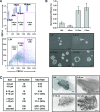Separation by cell size enriches for mammary stem cell repopulation activity
- PMID: 23408103
- PMCID: PMC3659766
- DOI: 10.5966/sctm.2012-0121
Separation by cell size enriches for mammary stem cell repopulation activity
Abstract
Mammary gland reconstitution experiments, as well as lineage tracing experiments, have provided evidence for the existence of adult mammary stem cells (MaSCs). In addition, cell sorting techniques for specific cell surface markers (CD24(+)CD29(H)CD49f(H)Sca1(-)) have been used to prospectively isolate MaSC-enriched populations. Although these markers enrich for cell subpopulations that harbor MaSCs, they do not identify regenerative stem cells uniquely. Here, we report that MaSCs can be further defined by the property of cell size. Fluorescence-activated cell sorting was used to analyze sizing beads and further separate populations of cells with varying degrees of forward scatter (FSC). Cells with a low FSC that were approximately <10 μm in size lacked outgrowth potential and failed to reconstitute the mammary gland when transplanted into the cleared fat pads of syngeneic mice. In contrast, cells >10 μm in size with a higher FSC had increased outgrowth potential as compared with lineage-negative (LIN(-)) control cells. Limiting dilution transplantation assays indicated that the repopulating ability of LIN(-)CD24(+)CD29(H) cells that were >10 μm in size was significantly increased as compared with cells marked by CD24 and CD29 alone. These results suggest that MaSCs can be further isolated by sorting based on size/FSC. These findings have critical implications for understanding mammary gland stem cell biology, an important requisite step for understanding the etiology of breast cancer.
Figures


Similar articles
-
Evidence for a multipotent mammary progenitor with pregnancy-specific activity.Breast Cancer Res. 2013;15(4):R65. doi: 10.1186/bcr3459. Breast Cancer Res. 2013. PMID: 23947835 Free PMC article.
-
CD24 and CD49f expressions of E14.5 mouse mammary anlagen cells define putative distribution of earlier embryonic mammary stem cell activities.Biochem Cell Biol. 2018 Oct;96(5):539-547. doi: 10.1139/bcb-2017-0177. Epub 2018 Apr 5. Biochem Cell Biol. 2018. PMID: 29620414
-
SCA-1 Labels a Subset of Estrogen-Responsive Bipotential Repopulating Cells within the CD24+ CD49fhi Mammary Stem Cell-Enriched Compartment.Stem Cell Reports. 2017 Feb 14;8(2):417-431. doi: 10.1016/j.stemcr.2016.12.022. Epub 2017 Jan 26. Stem Cell Reports. 2017. PMID: 28132885 Free PMC article.
-
Mammary gland stem cells: more puzzles than explanations.J Biosci. 2012 Jun;37(2):349-58. doi: 10.1007/s12038-012-9200-z. J Biosci. 2012. PMID: 22581339 Review.
-
The emerging picture of the mouse mammary stem cell.Stem Cell Rev. 2007 Jun;3(2):114-23. doi: 10.1007/s12015-007-0018-2. Stem Cell Rev. 2007. PMID: 17873344 Review.
Cited by
-
Hallmarks of the cancer cell of origin: Comparisons with "energetic" cancer stem cells (e-CSCs).Aging (Albany NY). 2019 Feb 13;11(3):1065-1068. doi: 10.18632/aging.101822. Aging (Albany NY). 2019. PMID: 30760648 Free PMC article.
-
Surface acoustic wave (SAW) techniques in tissue engineering.Cell Tissue Res. 2021 Nov;386(2):215-226. doi: 10.1007/s00441-020-03397-1. Epub 2021 Aug 14. Cell Tissue Res. 2021. PMID: 34390407 Review.
-
Stem cell research: a novel boulevard towards improved bovine mastitis management.Int J Biol Sci. 2013 Aug 20;9(8):818-29. doi: 10.7150/ijbs.6901. eCollection 2013. Int J Biol Sci. 2013. PMID: 23983615 Free PMC article. Review.
-
High mitochondrial mass identifies a sub-population of stem-like cancer cells that are chemo-resistant.Oncotarget. 2015 Oct 13;6(31):30472-86. doi: 10.18632/oncotarget.5401. Oncotarget. 2015. PMID: 26421710 Free PMC article.
-
Cancer stem cells and cell size: A causal link?Semin Cancer Biol. 2015 Dec;35:191-9. doi: 10.1016/j.semcancer.2015.07.002. Epub 2015 Aug 1. Semin Cancer Biol. 2015. PMID: 26241348 Free PMC article. Review.
References
-
- Shackleton M, Vaillant F, Simpson KJ, et al. Generation of a functional mammary gland from a single stem cell. Nature. 2006;439:84–88. - PubMed
-
- Smalley MJ, Kendrick H, Sheridan JM, et al. Isolation of mouse mammary epithelial subpopulations: A comparison of leading methods. J Mammary Gland Biol Neoplasia. 2012;17:91–97. - PubMed
-
- Stingl J, Eirew P, Ricketson I, et al. Purification and unique properties of mammary epithelial stem cells. Nature. 2006;439:993–997. - PubMed
-
- Moraes RC, Zhang X, Harrington N, et al. Constitutive activation of smoothened (SMO) in mammary glands of transgenic mice leads to increased proliferation, altered differentiation and ductal dysplasia. Development. 2007;134:1231–1242. - PubMed
Publication types
MeSH terms
Substances
Grants and funding
- CA154605/CA/NCI NIH HHS/United States
- CA127857/CA/NCI NIH HHS/United States
- S10RR027783-01A1/RR/NCRR NIH HHS/United States
- P39 CA125123-04/CA/NCI NIH HHS/United States
- P30DX56338-05A2/PHS HHS/United States
- P01 CA030195/CA/NCI NIH HHS/United States
- P30 DK056338/DK/NIDDK NIH HHS/United States
- U54 HD-07495-39/HD/NICHD NIH HHS/United States
- P50 CA058183/CA/NCI NIH HHS/United States
- S10 RR024574/RR/NCRR NIH HHS/United States
- P50 CA58183/CA/NCI NIH HHS/United States
- CA030195-22/CA/NCI NIH HHS/United States
- K99 CA154605/CA/NCI NIH HHS/United States
- P30CA125123/CA/NCI NIH HHS/United States
- R01 CA127857/CA/NCI NIH HHS/United States
- S10 RR027783/RR/NCRR NIH HHS/United States
- U54 HD007495/HD/NICHD NIH HHS/United States
- R00 CA154605/CA/NCI NIH HHS/United States
- P30 CA125123/CA/NCI NIH HHS/United States
- R01 CA016303/CA/NCI NIH HHS/United States
- NCRRS10RR024574/PHS HHS/United States
LinkOut - more resources
Full Text Sources
Other Literature Sources
Medical

